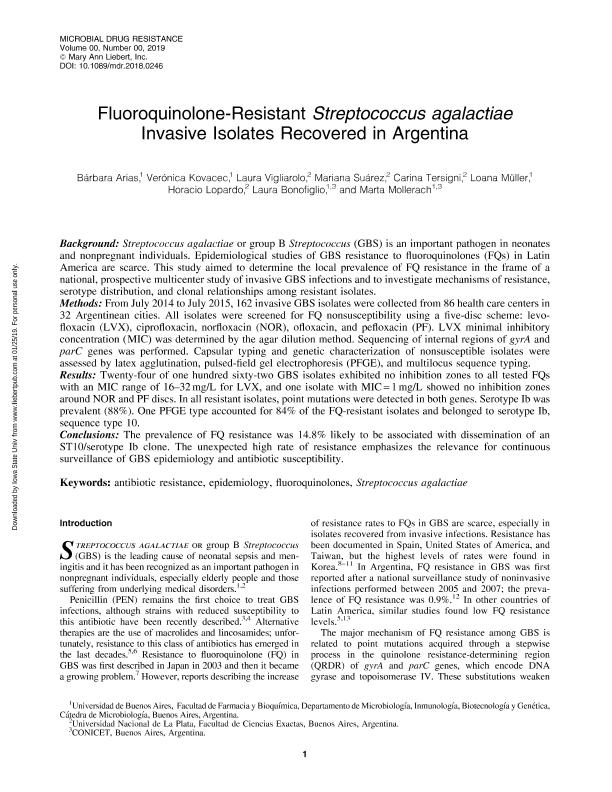Artículo
Fluoroquinolone-resistant streptococcus agalactiae invasive isolates recovered in Argentina
Arias, Bárbara Soledad; Kovacec, Verónica Ivana; Vigliarolo, Laura; Suárez, Mariana; Tersigni, Carina Laura; Müller, Loana; Lopardo, Horacio Angel; Bonofiglio, Laura ; Mollerach, Marta Eugenia
; Mollerach, Marta Eugenia
 ; Mollerach, Marta Eugenia
; Mollerach, Marta Eugenia
Fecha de publicación:
06/2019
Editorial:
Mary Ann Liebert
Revista:
Microbial Drug Resistance: Mechanisms Epidemiology and Disease
ISSN:
1076-6294
Idioma:
Inglés
Tipo de recurso:
Artículo publicado
Clasificación temática:
Resumen
Background: Streptococcus agalactiae or group B Streptococcus (GBS) is an important pathogen in neonates and nonpregnant individuals. Epidemiological studies of GBS resistance to fluoroquinolones (FQs) in Latin America are scarce. This study aimed to determine the local prevalence of FQ resistance in the frame of a national, prospective multicenter study of invasive GBS infections and to investigate mechanisms of resistance, serotype distribution, and clonal relationships among resistant isolates. Methods: From July 2014 to July 2015, 162 invasive GBS isolates were collected from 86 health care centers in 32 Argentinean cities. All isolates were screened for FQ nonsusceptibility using a five-disc scheme: Levofloxacin (LVX), ciprofloxacin, norfloxacin (NOR), ofloxacin, and pefloxacin (PF). LVX minimal inhibitory concentration (MIC) was determined by the agar dilution method. Sequencing of internal regions of gyrA and parC genes was performed. Capsular typing and genetic characterization of nonsusceptible isolates were assessed by latex agglutination, pulsed-field gel electrophoresis (PFGE), and multilocus sequence typing. Results: Twenty-four of one hundred sixty-two GBS isolates exhibited no inhibition zones to all tested FQs with an MIC range of 16-32 mg/L for LVX, and one isolate with MIC = 1 mg/L showed no inhibition zones around NOR and PF discs. In all resistant isolates, point mutations were detected in both genes. Serotype Ib was prevalent (88%). One PFGE type accounted for 84% of the FQ-resistant isolates and belonged to serotype Ib, sequence type 10. Conclusions: The prevalence of FQ resistance was 14.8% likely to be associated with dissemination of an ST10/serotype Ib clone. The unexpected high rate of resistance emphasizes the relevance for continuous surveillance of GBS epidemiology and antibiotic susceptibility.
Archivos asociados
Licencia
Identificadores
Colecciones
Articulos(OCA HOUSSAY)
Articulos de OFICINA DE COORDINACION ADMINISTRATIVA HOUSSAY
Articulos de OFICINA DE COORDINACION ADMINISTRATIVA HOUSSAY
Citación
Arias, Bárbara Soledad; Kovacec, Verónica Ivana; Vigliarolo, Laura; Suárez, Mariana; Tersigni, Carina Laura; et al.; Fluoroquinolone-resistant streptococcus agalactiae invasive isolates recovered in Argentina; Mary Ann Liebert; Microbial Drug Resistance: Mechanisms Epidemiology and Disease; 25; 5; 6-2019; 739-743
Compartir
Altmétricas



